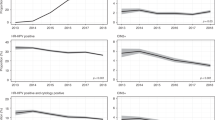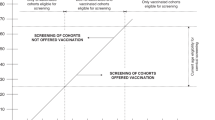Abstract
Background
Understanding the pattern and dominance of HPV types in high grade cervical disease within increasingly vaccinated populations will help inform the development of appropriate screening and management protocols.
Methods
Over 1700 cases of cervical intraepithelial neoplasia (CIN) diagnosed between 2011 and 2017 in women younger than 25 were genotyped for HPV. Logistic regression was used to assess the association between HPV 16/18 positivity with biopsy-collection year, birth year, deprivation and vaccination status. Regression analysis was repeated for cross-protective types (31, 33 and 45). Type specific detail of non-vaccine types by vaccination status was presented descriptively.
Results
Detection of HPV 16/18 or 16/18/31/33 and 45 was lower in CIN2 associated with full vaccination vs no vaccination (OR 0.3; 95% CI 0.2–0.5 & 0.4; 95% CI 0.3–0.6 respectively) Similar observations were made for CIN3. The relative contribution of non-established high-risk types including those considered low risk was greater among vaccinated women with CIN2+ vs unvaccinated women with CIN2+.
Conclusions
The change in HPV distribution in CIN2+ in vaccinated populations is a further marker of vaccine impact. Additionally, the progression rate of CIN2+ in vaccinated populations may be lower given the shift in type distribution. The definition of high grade disease in vaccinated populations may warrant reassessment.
This is a preview of subscription content, access via your institution
Access options
Subscribe to this journal
Receive 24 print issues and online access
$259.00 per year
only $10.79 per issue
Buy this article
- Purchase on Springer Link
- Instant access to full article PDF
Prices may be subject to local taxes which are calculated during checkout



Similar content being viewed by others
Data availability
Requests to access the aggregated data can be made to the corresponding author, any request for dissemination would need to follow due process of governance.
References
www.who.int/cancer/prevention/diagnosis-screening/cervical-cancer/en/.
Palmer T, Wallace L, Pollock KG, Cuschieri K, Robertson C, Kavanagh K, et al. Prevalence of cervical disease at age 20 after immunisation with bivalent HPV vaccine at age 12-13 in Scotland: retrospective population study. BMJ. 2019;365:1161. https://doi.org/10.1136/bmj.l1161.
Kavanagh K, Pollock KG, Cuschieri K, Palmer T, Cameron RL, Watt C, et al. Changes in the prevalence of human papillomavirus following a national bivalent human papillomavirus vaccination programme in Scotland: a 7-year cross-sectional study. Lancet Infect Dis. 2017;17:1293–302. https://doi.org/10.1016/S1473-3099(17)30468-1.
Cuschieri K, Kavanagh K, Moore C, Bhatia R, Love J, Pollock KG. Impact of partial bivalent HPV vaccination on vaccine-type infection: a population-based analysis. Br J Cancer. 2016;114:1261–4. https://doi.org/10.1038/bjc.2016.97.
Cruickshank ME, Pan J, Cotton SC, Kavanagh K, Robertson C, Cuschieri K, et al. Reduction in colposcopy workload and associated clinical activity following human papillomavirus (HPV) catch-up vaccination programme in Scotland: an ecological study. BJOG. 2017;124:1386–93. https://doi.org/10.1111/1471-0528.14562.
Falcaro M, Castañon A, Ndlela B, Checchi M, Soldan K, Lopez-Bernal J, et al. The effects of the national HPV vaccination programme in England, UK, on cervical cancer and grade 3 cervical intraepithelial neoplasia incidence: a register-based observational study. Lancet. 2021;398:2084–92. https://doi.org/10.1016/S0140-6736(21)02178-4.
Drolet M, Bénard É, Pérez N, Brisson M, HPV Vaccination Impact Study Group. Population-level impact and herd effects following the introduction of human papillomavirus vaccination programmes: updated systematic review and meta-analysis. Lancet. 2019;394:497–509. https://doi.org/10.1016/S0140-6736(19)30298-3.
Johnson Jones ML, Gargano JW, Powell M, Park IU, Niccolai LM, Bennett NM, et al. HPV-IMPACT Working Group. Effectiveness of 1, 2, and 3 doses of human papillomavirus vaccine against high-grade cervical lesions positive for human papillomavirus 16 or 18. Am J Epidemiol. 2020;189:265–76. https://doi.org/10.1093/aje/kwz253.
Kann H, Hortlund M, Eklund C, Dillner J, Faust H. Human papillomavirus types in cervical dysplasia among young HPV-vaccinated women: population-based nested case-control study. Int J Cancer. 2020;146:2539–46. https://doi.org/10.1002/ijc.32848.
Mariz FC, Gray P, Bender N, Eriksson T, Kann H, Apter D, et al. Sustainability of neutralising antibodies induced by bivalent or quadrivalent HPV vaccines and correlation with efficacy: a combined follow-up analysis of data from two randomised, double-blind, multicentre, phase 3 trials. Lancet Infect Dis. 2021;21:1458–68. https://doi.org/10.1016/S1473-3099(20)30873-2.
Stoler MH, Wright TC Jr, Ferenczy A, Ranger-Moore J, Fang Q, Kapadia M, et al. Routine use of adjunctive p16 immunohistochemistry improves diagnostic agreement of cervical biopsy interpretation: results from the CERTAIN Study. Am J Surg Pathol. 2018;42:1001–9. https://doi.org/10.1097/PAS.0000000000001072.
van der Marel J, Quint WG, Schiffman M, van de Sandt MM, Zuna RE, Dunn ST, et al. Molecular mapping of high-grade cervical intraepithelial neoplasia shows etiological dominance of HPV16. Int J Cancer. 2012;131:E946–53. https://doi.org/10.1002/ijc.27532.
Karube A, Saito F, Waga M, Yokoyama S, Kanamori K. Progression of cervical intraepithelial neoplasia grade 2 lesions among Japanese women harboring different genotype categories of high-risk human papillomaviruses. J Rural Med. 2021;16:91–97. https://doi.org/10.2185/jrm.2020-038.
Cuschieri K, Brewster DH, Williams AR, Millan D, Murray G, Nicoll S, et al. Distribution of HPV types associated with cervical cancers in Scotland and implications for the impact of HPV vaccines. Br J Cancer. 2010;102:930–2. https://doi.org/10.1038/sj.bjc.6605556.
Mesher D, Cuschieri K, Hibbitts S, Jamison J, Sargent A, Pollock KG, et al. Type-specific HPV prevalence in invasive cervical cancer in the UK prior to national HPV immunisation programme: baseline for monitoring the effects of immunisation. J Clin Pathol. 2015;68:135–40. https://doi.org/10.1136/jclinpath-2014-202681.
Shing JZ, Hu S, Herrero R, Hildesheim A, Porras C, Sampson JN, et al. Costa Rica HPV Vaccine Trial Group. Precancerous cervical lesions caused by non-vaccine-preventable HPV types after vaccination with the bivalent AS04-adjuvanted HPV vaccine: an analysis of the long-term follow-up study from the randomised Costa Rica HPV Vaccine Trial. Lancet Oncol. 2022;23:940–9. https://doi.org/10.1016/S1470-2045(22)00291-1.
Arbyn M, Simon M, Peeters E, Xu L, Meijer CJLM, Berkhof J, et al. 2020 list of human papillomavirus assays suitable for primary cervical cancer screening. Clin Microbiol Infect. 2021;27:1083–95. https://doi.org/10.1016/j.cmi.2021.04.031.
Lehtinen M, Pimenoff VN, Nedjai B, Louvanto K, Verhoef L, Heideman DAM et al. Assessing the risk of cervical neoplasia in the post-HPV vaccination era. Int J Cancer. 2022. https://doi.org/10.1002/ijc.34286.
Salvadó A, Miralpeix E, Solé-Sedeno JM, Kanjou N, Lloveras B, Duran X, et al. Predictor factors for conservative management of cervical intraepithelial neoplasia grade 2: Cytology and HPV genotyping. Gynecol Oncol. 2021;162:569–74. https://doi.org/10.1016/j.ygyno.2021.06.019.
Acknowledgements
The authors would like to thank the teams at the NHS Pathology Laboratories in Scotland that supported the field work and sample collation, the operational team at the Scottish HPV Reference Laboratory who supported with delivery of the HPV genotyping and Ms Helen Watson & Dr Kevin Pollock, previously based at Public Health Scotland for their contribution to early work on this initiative.
Funding
This work was funded by the Scottish Government.
Author information
Authors and Affiliations
Contributions
KC co-ordinated the fieldwork, sample collation and the laboratory testing and created the working manuscript draft, TP supported with data analysis and manuscript drafting, and provided critical comment on analysis, CG performed the statistical analysis and commented on early and later manuscript drafts, RC was involved in the initial planning of the work and provided input on study design, KR is lead for the HPV immunisation surveillance at Public Health Scotland, provided critical comment on analysis and contributed to manuscript drafting.
Corresponding author
Ethics declarations
Competing interests
The work was performed as part of National HPV immunisation surveillance in Scotland, which is coordinated though Public Health Scotland (PHS). TP, RC and KR are employees of PHS. KC is Director of the Scottish HPV Reference Laboratory which is commissioned to deliver HPV testing and typing to inform Public Health surveillance. CG declares no competing interests.
Ethics approval and consent to participate
Records were anonymised before analysis, with preservation of linkage between immunisation and histology when appropriate. Caldicott Guardian approval, a UK process to ensure that the use of personal data complies with legal requirements for data protection and is in the public interest, was obtained for the use of data. The samples were generated through the routine activity of the Scottish cervical screening programme. Participation in the programme gives implied consent for the use of data derived from this participation for service monitoring and improvement. Management of individual patients was not affected by this study.
Consent for publication
The manuscript contains aggregate data only and does not contain person-level data.
Additional information
Publisher’s note Springer Nature remains neutral with regard to jurisdictional claims in published maps and institutional affiliations.
Supplementary information
Rights and permissions
Springer Nature or its licensor (e.g. a society or other partner) holds exclusive rights to this article under a publishing agreement with the author(s) or other rightsholder(s); author self-archiving of the accepted manuscript version of this article is solely governed by the terms of such publishing agreement and applicable law.
About this article
Cite this article
Cuschieri, K., Palmer, T., Graham, C. et al. The changing nature of HPV associated with high grade cervical lesions in vaccinated populations, a retrospective study of over 1700 cases in Scotland. Br J Cancer 129, 1134–1141 (2023). https://doi.org/10.1038/s41416-023-02386-9
Received:
Revised:
Accepted:
Published:
Issue Date:
DOI: https://doi.org/10.1038/s41416-023-02386-9



